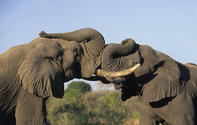Elephant Clans
If elephant herds become too large they may split up with a group of closely related cows and their young forming a new herd.

The separated herds or kinship groups remain in contact with each other due to their relatedness. These groups are also linked to more distantly related herds in what are known as clans. Clans will frequent particular homeranges, which are associated with the ranges of bull elephants.
Within an area, bull elephants all recognize each other and a local hierarchy, which is abandoned during times of musth, is established from early in life through ritualized play fighting. These encounters continue until bulls are 40 years old and indicate, without risk of injury, a particular individual’s strength.
Allo-mothering

From a relatively early age, female elephants practice allo-mothering or ‘nannying’ during which they guide calves assisting them over obstacles, teaching them what to eat (some calves even remove food from other elephants’ mouths to learn what to eat) and protecting them just as the mother does.
This provides a support network for the calves as well as important practice to the young cows for when they become mothers. While young female elephants practice how to become successful mothers, young bulls spend time practising head-butting and play mounting to establish rank between themselves and to develop skills that they will use to win dominance later in life.
By Megan Emmett